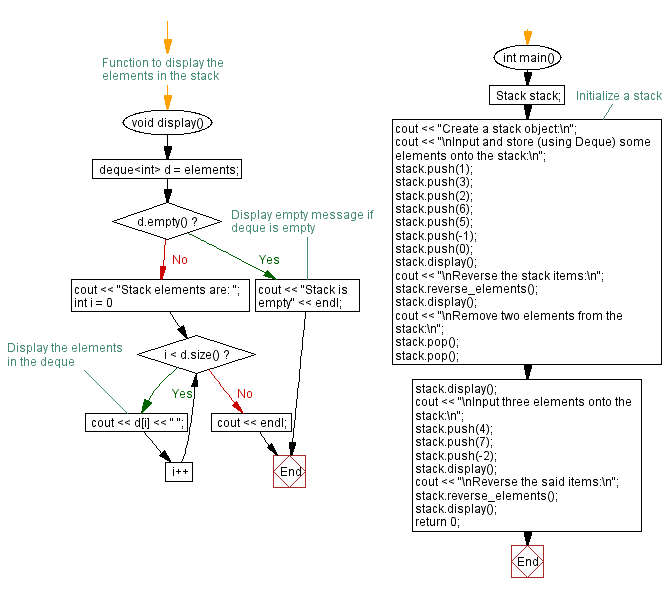C++ Reverse the stack (using a Deque) elements
30. Reverse the Elements of a Deque-Based Stack
Write a C++ program that reverse the stack (using a Deque) elements.
Test Data:
Create a stack object:
Input and store (using Deque) some elements onto the stack:
Stack elements are: 1 3 2 6 5 -1 0
Reverse the stack items in ascending order:
Stack elements are: 0 -1 5 6 2 3 1
Sample Solution:
C++ Code:
#include <iostream>
#include <deque>
#include <algorithm>
using namespace std;
class Stack {
private:
deque<int> elements; // Deque to store elements
public:
// Function to add an element to the stack
void push(int element) {
elements.push_back(element); // Add element to deque
}
// Function to remove an element from the stack
void pop() {
if (elements.empty()) {
cout << "Stack underflow" << endl; // Display underflow message if deque is empty
} else {
elements.pop_back(); // Remove last element from deque
}
}
// Function to get the top element of the stack
int top() {
if (elements.empty()) {
cout << "Stack is empty" << endl; // Display empty message if deque is empty
return 0;
} else {
return elements.back(); // Return last element in deque
}
}
// Function to check if the stack is empty
bool empty() {
return elements.empty(); // Check if deque is empty
}
// Function to reverse elements in the stack
void reverse_elements() {
if (elements.empty()) {
cout << "Stack is empty" << endl; // Display empty message if deque is empty
return;
}
reverse(elements.begin(), elements.end()); // Reverse elements
}
// Function to display the elements in the stack
void display() {
deque<int> d = elements;
if (d.empty()) {
cout << "Stack is empty" << endl; // Display empty message if deque is empty
return;
}
cout << "Stack elements are: ";
for (int i = 0; i < d.size(); i++) {
cout << d[i] << " "; // Display the elements in the deque
}
cout << endl;
}
};
int main() {
Stack stack;
//Initialize a stack
cout << "Create a stack object:\n";
cout << "\nInput and store (using Deque) some elements onto the stack:\n";
stack.push(1);
stack.push(3);
stack.push(2);
stack.push(6);
stack.push(5);
stack.push(-1);
stack.push(0);
stack.display();
cout << "\nReverse the stack items:\n";
stack.reverse_elements();
stack.display();
cout << "\nRemove two elements from the stack:\n";
stack.pop();
stack.pop();
stack.display();
cout << "\nInput three elements onto the stack:\n";
stack.push(4);
stack.push(7);
stack.push(-2);
stack.display();
cout << "\nReverse the said items:\n";
stack.reverse_elements();
stack.display();
return 0;
}
Sample Output:
Create a stack object: Input and store (using Deque) some elements onto the stack: Stack elements are: 1 3 2 6 5 -1 0 Reverse the stack items: Stack elements are: 0 -1 5 6 2 3 1 Remove two elements from the stack: Stack elements are: 0 -1 5 6 2 Input three elements onto the stack: Stack elements are: 0 -1 5 6 2 4 7 -2 Reverse the said items: Stack elements are: -2 7 4 2 6 5 -1 0
Flowchart:



For more Practice: Solve these Related Problems:
- Write a C++ program to reverse a deque-based stack by reordering its elements and displaying the result.
- Develop a C++ program that uses a deque to implement a stack and then prints the elements in reverse order.
- Design a C++ program to implement a deque-based stack and reverse its elements by swapping the front and back items.
- Implement a C++ program to create a stack using a deque and output the reversed sequence by manually iterating through the container.
Go to:
PREV : Sort the Elements of a Deque-Based Stack.
NEXT : C++ Numbers Exercises Home.
CPP Code Editor:
Contribute your code and comments through Disqus.
What is the difficulty level of this exercise?
